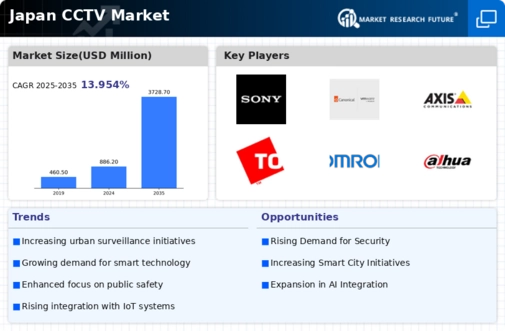Rising Security Concerns
In Japan, the increasing concerns regarding public safety and security are driving the demand for the cctv market. With urban areas experiencing higher crime rates, there is a notable push for enhanced surveillance systems. According to recent data, the market is projected to grow at a CAGR of 8.5% from 2025 to 2030. This growth is fueled by both residential and commercial sectors seeking to implement advanced security measures. The cctv market is responding by innovating with high-definition cameras and smart analytics, which are becoming essential tools for crime prevention and investigation. As citizens demand safer environments, the integration of these technologies into everyday life is likely to expand, further solidifying the role of cctv systems in urban planning and community safety.
Government Initiatives and Funding
The Japanese government is actively promoting the adoption of surveillance technologies, which significantly impacts the cctv market. Initiatives aimed at enhancing public safety through funding and support for local municipalities are becoming more prevalent. For instance, the government has allocated substantial budgets for the installation of cctv systems in public spaces, which is expected to reach approximately ¥50 billion by 2026. This financial backing not only encourages local authorities to invest in cctv infrastructure but also stimulates private sector participation. The cctv market is thus positioned to benefit from these initiatives, as they create a conducive environment for technological advancements and widespread implementation of surveillance systems across various sectors.
Technological Integration and Innovation
The cctv market in Japan is witnessing a surge in technological integration, particularly with the advent of artificial intelligence and machine learning. These innovations are enhancing the capabilities of surveillance systems, allowing for real-time monitoring and advanced analytics. The market is expected to see a growth rate of 10% annually as businesses and public institutions increasingly adopt these technologies. Features such as facial recognition, motion detection, and automated alerts are becoming standard in new installations. This trend indicates a shift towards more intelligent surveillance solutions, which not only improve security but also optimize resource allocation within the cctv market. As technology continues to evolve, the demand for sophisticated cctv systems is likely to rise, further transforming the landscape of public safety.
Urbanization and Infrastructure Development
Japan's rapid urbanization is significantly influencing the cctv market. As cities expand and infrastructure develops, the need for effective surveillance systems becomes paramount. The urban population is projected to reach 90% by 2030, necessitating enhanced security measures in densely populated areas. This demographic shift is prompting local governments and businesses to invest in cctv systems to monitor public spaces, transportation hubs, and commercial districts. The cctv market is adapting to these changes by offering scalable solutions that cater to the unique needs of urban environments. The integration of cctv systems into urban planning is likely to become a standard practice, ensuring that safety and security keep pace with growth.
Increased Demand for Remote Monitoring Solutions
The demand for remote monitoring solutions is on the rise within the cctv market in Japan. As businesses and homeowners seek greater control over their security systems, the ability to monitor feeds remotely via smartphones and other devices is becoming increasingly desirable. This trend is reflected in the market's projected growth, with an estimated increase of 12% in remote monitoring system installations over the next five years. The cctv market is responding by developing user-friendly applications and cloud-based storage solutions that enhance accessibility and convenience. This shift towards remote capabilities not only improves security but also aligns with the growing trend of smart home technologies, indicating a broader movement towards integrated security solutions.























Leave a Comment